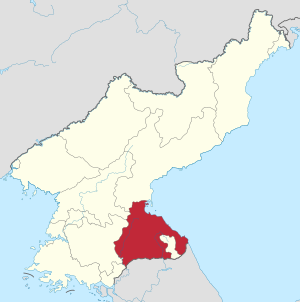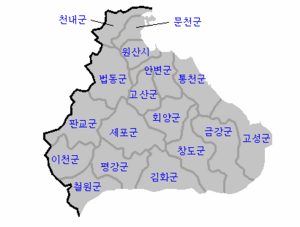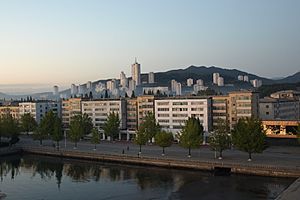Kangwon Province, North Korea facts for kids
Quick facts for kids
Kangwon Province
강원도
|
|
|---|---|
| Korean transcription(s) | |
| • Chosŏn'gŭl | 강원도 |
| • Hancha | 江原道 |
| • McCune–Reischauer | Kangwŏndo |
| • Revised Romanization | Gangwon-do |
 |
|
| Country | North Korea |
| Region | Gwandong (Yeongseo: western Kangwŏn; Yeongdong: eastern Kangwŏn) |
| Capital | Wŏnsan |
| Subdivisions | 2 cities; 15 counties |
| Area | |
| • Total | 11,255 km2 (4,346 sq mi) |
| Population
(2008)
|
|
| • Total | 1,477,582 |
| • Density | 131.282/km2 (340.020/sq mi) |
| Time zone | UTC+9 (Pyongyang Time) |
Kangwon Province (also called Kangwŏndo) is a province in North Korea. Its capital city is Wŏnsan. Before Korea was divided in 1945, Kangwon Province was part of a larger single province. This older province also included what is now Gangwon Province in South Korea.
Contents
History of Kangwon Province
Kangwon was one of the Eight Provinces of Korea during the Joseon Dynasty. This was a long period in Korean history. The province was first created in 1395. Its name came from parts of the names of two important cities: Gangneung (or Kangnŭng) and Wonju (or Wŏnju). Wonju used to be the capital of the province.
Changes Over Time
In 1895, Kangwon Province was split into two smaller areas called districts. These were Chuncheon District in the west and Gangneung District in the east. Wonju, the old capital, became part of another area.
However, in 1896, Korea was reorganized again. The two districts were put back together to form Kangwon Province once more. Wonju rejoined the province, but the capital was moved to Chuncheon.
Division and New Capital
In 1945, Korea was divided into two parts after World War II. The northern part was controlled by the Soviet Union, and the southern part by the United States of America. Kangwon Province was split by this division, along the 38th parallel north.
In 1946, the northern part of Kangwon Province grew bigger. It took in some land from Gyeonggi Province and the area around Wŏnsan from South Hamgyŏng Province. Since the old capitals, Wonju and Chuncheon, were now in the southern part of Korea, a new capital was chosen for North Korea's Kangwon Province: Wŏnsan.
In 1948, this northern province became part of the new country, the Democratic People's Republic of Korea. After the Korean War ended in 1953, the border between North and South Korea shifted. This new border is called the Military Demarcation Line.
In 2002, a special area called the Mount Kumgang Tourist Region was created. It was separated from the rest of Kangwon Province to be managed differently, mainly for tourism.
Geography of Kangwon Province
Kangwon Province is located on the eastern side of North Korea. To its north is South Hamgyŏng Province. To its west are South P'yŏngan and North Hwanghae provinces. To the south, it borders Kaesŏng.
The province also shares a border with its South Korean neighbor, Gangwon, across the Korean Demilitarized Zone. To the east, the province meets the Sea of Japan.
Mountains and Regions
The province is mostly covered by the Taebaek Mountains. The highest point in these mountains is Mount Kumgang, which means "Diamond Mountain."
Kangwon Province in North Korea and Gangwon Province in South Korea are sometimes together called the Gwandong region. The area to the west of the Taebaek Mountains is known as Yŏngsŏ. The area to the east of the mountains is called Yŏngdong.
Nature and Conservation
In April 2003, the Mt. Chuae Plant Reserve was created. This special area covers about 687 hectares. It is located in Shindong-ri, Sepho County, and Sanyang-ri, Kosan County. Mt. Chuae is 1,528 meters high and is part of the Masingnyong Mountains.
The DPRK Nature Conservation Union works to protect the mixed forests in this area, which have both pine and broad-leaf trees. The government has made rules to protect the environment here. These rules stop people from letting animals graze, collecting plants, or doing anything else that could harm the natural area.
Administrative Divisions
Kangwon Province is divided into different parts for easier management. It has 2 cities (called si), 1 special administrative region, and 15 counties (called kun).
Cities
- Munchŏn-si (문천시)
- Wŏnsan-si (원산시)
Counties
- Anbyŏn-gun (안변군)
- Ch'angdo-gun (창도군)
- Ch'ŏnnae-gun (천내군)
- Ch'ŏrwŏn-gun (철원군)
- Hoeyang-gun (회양군)
- Ich'ŏn-gun (이천군)
- Kimhwa-gun (김화군)
- Kosan-gun (고산군)
- Kosŏng-gun (고성군)
- Kŭmgang-gun (금강군)
- Mount Kumgang Tourist Region (금강산 관광 지구)
- P'an'gyo-gun (판교군)
- Pŏptong-gun (법동군)
- P'yŏnggang-gun (평강군)
- Sep'o-gun (세포군)
- T'ongch'ŏn-gun (통천군)
See also
 In Spanish: Provincia de Kangwon para niños
In Spanish: Provincia de Kangwon para niños



